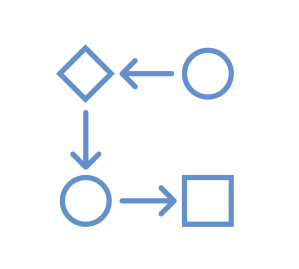All investments involve risk, including possible loss of principal. Carefully consider key risk factors prior to investing.
Summary
- Software is an “industry of industries” given the embedded nature of software solutions across diverse industry ecosystems, supply chains and end markets.
- OHA is one of the earliest software credit investors with over 20 years of experience and deep expertise gained investing $31 billion across more than 140 software credits.1
- OHA believes software companies can offer attractive all-weather investment profiles resulting from mission critical workflows, larger competitive moats, contractual recurring revenue, limited correlation to end markets and lower capital expenditures.
- Additionally, OHA avoids investments in software businesses that it views as offering equity-like risk versus credit risk. This includes vendors of consumer software, commoditized solutions and annualized recurring revenue (ARR) loans.
Learn more about OHA’s software lending business that has invested over $31B in more than 140 software credits since 2004.
Large Cap Software Credit
Software is the largest sector in the leveraged finance market, more than double the size of the next largest sector.2 Within software credit, OHA generally seeks larger companies that are more established and dominant in their markets, rather than younger, emerging businesses. OHA typically defines larger companies as having annual earnings before interest, taxes, depreciation and amortization (EBITDA) of greater than $75 million per year.
OHA invests in companies that provide mission-critical workflow enablement or IT infrastructure solutions to its customers. OHA believes that the universe of industry vertical-specific software businesses, each catering to specific end markets, offers an attractive opportunity to invest. Within this universe we aim, via our proprietary research, to build a portfolio of credits with similar defensive characteristics but diversified across end markets. OHA has a long history of lending to software companies that offer high value functionality for large industries such as healthcare, banking, insurance, public sector, manufacturing and beyond. The essential nature and value proposition of these software solutions over time make them very difficult to replace in company infrastructures and industry ecosystems. We select for businesses that we believe are capable of generating reliable cash flows sufficient to support levered capital structures. These companies typically also garner high valuations, which reflect the attractive business attributes described below, providing attractive equity cushions below OHA’s credit investments.
These candidates should not be confused with mega-cap technology companies or high growth investment themes like the adoption of artificial intelligence. OHA believes more nascent technologies often face significant technology risk as well as execution challenges from evolving regulatory regimes and competition. These investment profiles are better suited to equity investors who expect higher return while accepting higher risk than a credit investor.
Within this market, OHA seeks to source and structure software credit investments that offer attractive returns and strong downside protection with a focus on loss avoidance.
When constructing a portfolio, business software also offers inherent diversification as an “industry of industries” that is integral to the functioning of all sectors and segments of the economy.
Next, we discuss the characteristics of software companies that OHA believes offer this investment profile.
1 As of December 31, 2023. Based on total capital Invested for firmwide investments in software companies from 2004 – 2023 including private and syndicated investments.
2 Source: Morningstar LSTA Leveraged Loan Index as of March 31, 2024.
Key Characteristics of OHA Software Targets

Mission Critical Workflows
Enterprise workflow software that acts as a system of record for core data and automates the daily functions of a business is mission critical to an enterprise. As a company integrates a workflow software system, more and more employees become knowledgeable and efficient with the software and often operate entirely (or almost entirely) within it, and structure their core business processes around it.
Take, for example, the needs of an insurance brokerage for a software system to quote insurance rates from multiple insurers, calculate share of premium to the broker, store and retrieve customer policies, track profit and loss of the brokerage and more. The brokerage always needs this system, regardless of whether demand for insurance is increasing or decreasing at any given time.

Larger Competitive Moats
Mission critical software businesses can become highly entrenched because they provide functionality that is core to customer operations and risky, difficult and costly to replace. The high costs and operational risk create a material disincentive for customers to replace incumbent software applications. Continuing the insurance brokerage example above, switching to a different vendor may cause critical software to go offline, potentially bringing a broker’s customer revenue generation to a complete halt and leading to the loss of customers as they cannot access their policies. Furthermore, this aspect of software insulates the business from employee turnover. It is more difficult for a salesperson to bring customer relationships with them to a competitor if migrating away from their existing software is challenging.

Contractual Recurring Revenue
OHA favors software companies that emphasize recurring revenue contracts that result in stickier and more predictable revenue streams. For example, OHA seeks software providers with revenue tied to the number of users or the amount of data managed as opposed to the number of clicks or processed transactions. Additionally, OHA prefers mature companies with an established customer base, providing software with out-of-the-box functionality for highly regulated, risk averse industries, such as financial services, state or local governments and educational institutions.

Limited Correlation to End Market
OHA believes the business characteristics and revenue models described above provide insulation from end market cyclicality and lower macroeconomic risk. The “pipes and plumbing” nature of enterprise software effectively makes it a business utility that the installed base of clients is reluctant to “turn off”. As a result, the performance of these software companies will have limited correlation to the health of customer end markets through cycles.

Lower Capital Expenditures
A software company’s largest expenses are typically software engineers and salespeople, or in other words, their employees. In tight labor markets, companies may reduce attrition and replacement costs by investing in retention initiatives that promote employee engagement. During periods of economic pressure, such as higher interest rate environments, software businesses are relatively easily able to reduce costs by making intentional headcount reductions while ensuring core talent is retained. With no need to invest cash in manufacturing equipment or facilities, profit dollars are converted almost entirely into free cash flow. This flexibility around the cost base and low capital intensity lowers the risk of material impairment of software credits compared to other industries with more rigid cost structures and higher demands for capital investment.
When combined, OHA believes these characteristics of software businesses enhance their ability to navigate various economic cycles and reduce the chance of losses for credit investors.
Past performance is not indicative of future results.
Characteristics OHA Avoids

Consumer Software
OHA generally avoids direct-to-consumer businesses given their lack of competitive moats. Unlike providing critical software to established companies, consumer software can be quick for users to learn and thus easy to replace. In contrast, enterprise application software, such as ERP systems, takes time – in many case years – to install and learn as it becomes embedded in everyday business processes.

Commoditized Solutions
OHA generally avoids lending to providers of software solutions that are generic and lack meaningful differentiation from their peers. One example is anti-virus vendors, which are highly susceptible to replacement as competitors continuously develop slightly better solutions that are easily implemented. Software vendors focused on delivery of third-party learning content, which lacks industry or use-case differentiation, are also vulnerable to replication and replacement. These types of businesses typically operate in a rapidly changing landscape, creating constant threat of new entrants. They face very low switching costs, high technology risk and pricing pressure, which lead to lower inherent stickiness compared to mission critical workflow or infrastructure software businesses.

Annualized Recurring Revenue (ARR) Loans
OHA lends to businesses based on cash flow, not revenue. The premium paid for lending to revenue-based credits with little, or even negative, profit, in our view, generally does not compensate for the risk. We are proud to be among the early credit investors in software, where starting over 20 years ago we began investing in businesses with strong cash flow characteristics and intellectual property but limited hard asset collateral – something that was perceived as risky at that time. We remain confident in the space and in our thesis around cash flow and have opted not to make a single ARR loan to date.3
3Based on the OHA Private Lending Representative Transactions Record (PLRTR) as of March 31, 2024.
Takeaways
OHA believes software credit represents an opportunity to seek attractive return potential, diversification and downside protection, making it particularly attractive when compared to other industries.
We approach the sector with more than 30 years of credit investing experience and a one-team investment philosophy. We have developed an in-depth knowledge of issuers, industries and markets, including software and industries that comprise the clients of software companies. Our software investment team collaborates closely with the other industry specialist teams as part of our integrated model, sharing deep expertise that spans the entire below investment grade credit universe in liquid and private markets.
We approach software with an eye for mature companies, selling mission critical systems that lock in recurring revenue and offer some shielding from economic cycles. We believe software credit can be an all-weather addition to investment portfolios. We also believe that successful software credit investing over time requires deep and consistent industry expertise to enhance sourcing and underwriting and optimize results through credit selection.
Latest insights
Fall 2024
The “Magnificent Seven” Lender Protections
Learn more about the key lender protections OHA negotiates in its credit agreements to enhance protection for investors.
Spring 2024
Credit Market Observations
Delve into OHA's analysis of credit markets, covering a wide range of assets including private, liquid, and structured credit.
From the Field | 2024
Why company size matters in direct lending
Explore OHA's insight on larger borrowers in private credit and why company size matters in direct lending.
Key Risks and Disclosures
This document is for informational purposes only and does not constitute an offer to sell or a solicitation of an offer to buy any securities or partnership interests. Any investor who subscribes, or proposes to subscribe, for an investment in a fund or separately managed account must be able to bear the risks involved and must meet relevant suitability requirements. Fixed-income securities are subject to credit risk, liquidity risk, call risk, and interest-rate risk. As interest rates rise, bond prices generally fall. Investments in high-yield bonds involve greater risk of price volatility, illiquidity, and default than higher-rated debt securities. International investments can be riskier than U.S. investments due to the adverse effects of currency exchange rates, differences in market structure and liquidity, as well as specific country, regional, and economic developments. Some or all alternative investments may not be suitable for certain investors. No assurance can be given that a fund or separately managed account’s investment objectives will be achieved. Alternative investments are speculative and involve a substantial degree of risk. Opportunities for withdrawal/redemption and transferability of interests are generally restricted, so investors may not have access to capital when it is needed. The use of leverage will magnify the potential for loss on amounts invested. The use of a single advisor applying generally similar trading programs could mean lack of diversification and, consequently, higher risk. The use of leverage and other speculative practices may increase the risk of investment loss or make investment performance volatile. In addition, the fees and expenses charged may be higher than the fees and expenses of other investment alternatives, which will reduce profits. There can be no assurance that an advisor will be able to implement its strategy or avoid incurring any losses.
Diversification cannot assure a profit or protect against loss in a declining market.
Opinions and estimates offered herein constitute the judgment of OHA as of the date this document is provided to you (unless otherwise noted) and are subject to change, as are statements about market trends. All opinions and estimates are based on assumptions, all of which are difficult to predict and many of which are beyond the control of OHA in addition, any calculations used to generate the estimates were not prepared with a view towards public disclosure or compliance with any published guidelines. In preparing this document, OHA has relied upon and assumed, without independent verification, the accuracy and completeness of all information. OHA believes that the information provided herein is reliable; however, it does not warrant its accuracy or completeness.
This document may contain, or may be deemed to contain, forward-looking statements, which are statements other than statements of historical facts. By their nature, forward-looking statements involve risks and uncertainties because they relate to events and depend on circumstances that may or may not occur in the future. The future of investment results of the investments described herein may vary from the results expressed in, or implied by, any forward-looking statements included in this document, possibly to a material degree.
The recipient may contact OHA at (212) 326-1500 to obtain additional information or ask questions about any information, including the methodology used for any calculations and details concerning any of the summary charts or information provided herein.
©2024 Oak Hill Advisors. All Rights Reserved. OHA is a trademark of Oak Hill Advisors, L.P. All other trademarks shown are the property of their respective owners. Use does not imply endorsement, sponsorship, or affiliation of Oak Hill Advisors with any of the trademark owners.
Important Information
This material is provided for informational purposes only and is not intended to be investment advice or a recommendation to take any particular investment action.
The views contained herein are those of the authors as of July 2024 and are subject to change without notice; these views may differ from those of other T. Rowe Price associates.
This information is not intended to reflect a current or past recommendation concerning investments, investment strategies, or account types, advice of any kind, or a solicitation of an offer to buy or sell any securities or investment services. The opinions and commentary provided do not take into account the investment objectives or financial situation of any particular investor or class of investor. Please consider your own circumstances before making an investment decision.
Past performance is not a reliable indicator of future performance. All investments are subject to market risk, including the possible loss of principal. All charts and tables are shown for illustrative purposes only.
T. Rowe Price Investment Services, Inc. OHA is a T. Rowe Price company.
©2024 T. Rowe Price. All Rights Reserved. T. ROWE PRICE, INVEST WITH CONFIDENCE, and the Bighorn Sheep design are, collectively and/or apart, trademarks of T. Rowe Price Group, Inc.
202407-3752344
You are using an unsupported browser that might prevent you from accessing certain features on our site
We suggest clicking an icon below to download a supported browser.

